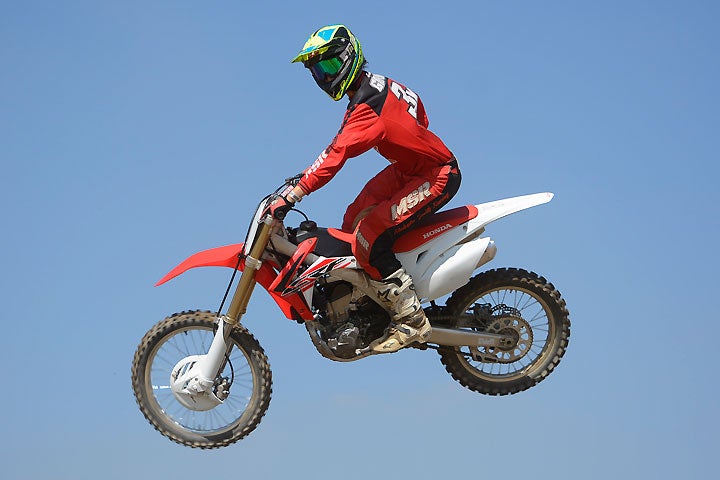
When we announce that a dirtbike is “unchanged” from one model year to the next, we don’t usually mean that in the most literal sense. Even if a manufacturer doesn’t make wholesale updates to its model, there will usually be a minor tweak or two—a fuel mapping update, a different coating on the wheels or other hard parts, bold new graphics…
But when we say that the 2017 CRF250R is completely unchanged, you can take that to the bank. Honda’s quarter-liter machine is so untouched that even the graphics are identical to the 2016 model. The running joke, according to Honda officials, is that the new sticker adorning the CRF’s aluminum perimeter frame to denote that it is, in fact, a 2017 model, is worth two horsepower.
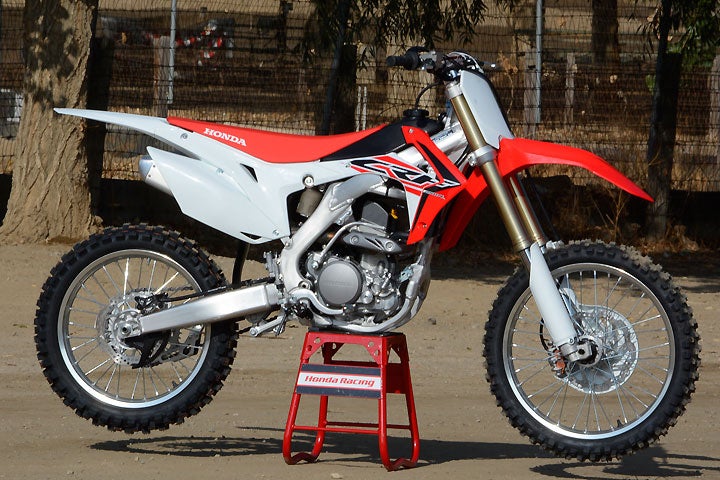
But that doesn’t mean that the CRF250R is a joke. It’s still a great bike that is in dire need of more engine performance in order to rank at the top of the 250cc motocross class.
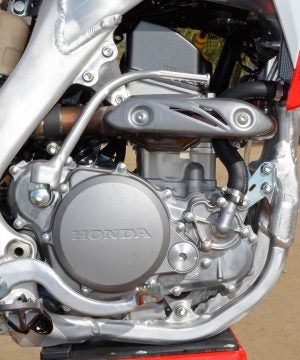
The CRF250R retains the liquid-cooled, fuel-injected, Unicam SOHC single-cylinder motor that did receive some attention to improve its power character in 2016. The 76.8mm x 53.8mm bore and stroke calculates out to 249cc Fuel is fed through Honda’s Dual-Timing PGM-FI system, which features a 46mm Keihin throttle body size is the same. Honda managed to squeeze a little more power out of the CRF250R in 2016 by lightening the piston and rod, bumping compression from 13.5:1 to 13.8:1, installing a higher-lift camshaft and valve springs and swapping the engine’s steel exhaust valves from steel to titanium. Outside the engine, CRF’s intake boot was boosted to improve air flow, and its exhaust system was redesigned by adding a torque-boosting resonator chamber and increasing the inner diameter of the outlets on its dual mufflers. For 2017, the specs are identical.
To give us an impression of the 2017 CRF250R, we had expert test rider Nic Garvin swing a leg over the 2017 Honda CRF250R at Milestone MX Park in Riverside, California, and after spinning several laps aboard the bike, his number one complaint had to do with the engine.
“It doesn’t feel fast at all,” Garvin said. “The motor comes on strong down low and through the middle, but it flattens out way too early on top. You really have to short shift it and be aggressive on the throttle.”
It’s funny how opinions change. Last year we praised the Honda’s power increase during our 2016 Honda CRF250R Review, noting that it did feel stronger, especially down low and through the middle of the rev range. But in light of the continued upgrades and/or outright changes made to some of its competition, the CRF is now lagging in power production.
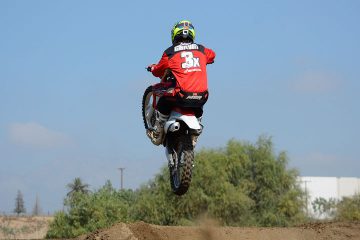
The good news, Garvin said, is that the CRF’s five-speed transmission and non-hydraulic clutch still perform well, offering smooth and crisp shifting and a linear feel that makes feeding power to the rear wheel easy. The only change Honda made last year was to install a new shift drum stopper with a bearing added to the roller in order to improve shifting feel under a load, making an already great transmission even better.
“The transmission is so smooth, and you can bang a shift at any rpm without worrying about missing a gear,” Garvin said. “And I think the clutch by far my favorite on any bike we’ve tested this year. It has a great feel. You can really rev the bike, and the clutch stays smooth and precise, even when you’re slipping it. It just has a consistently good feel and grip.”
Although he ultimately chose to ride the 2017 CRF250R with the most aggressive engine-mapping, Garvin also liked playing with the Honda’s Engine Mode Select Button engine mapping feature, which offers the rider access to select one of three preset engine maps. The user can customize the maps in Modes 2 and 3. Although Honda doesn’t offer an accessory handheld unit to facilitate these changes, adjustments can be made via a mobile phone app.
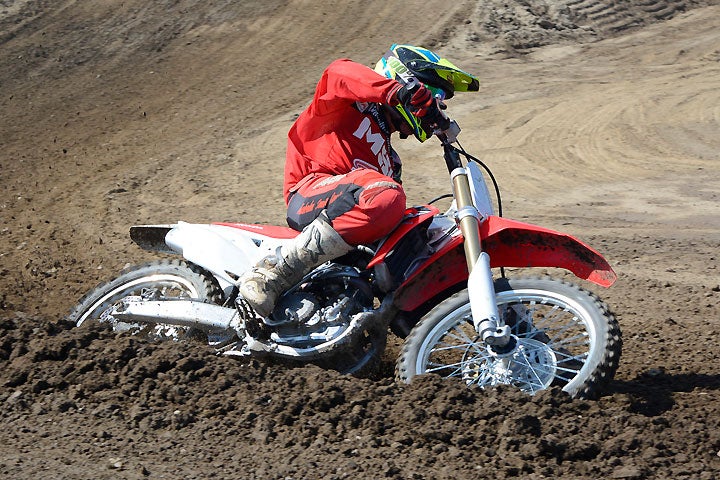
So, the CRF250R could use more power, but one thing it doesn’t need is a better-handling chassis. Now in its third year without a major revision, the Honda’s aluminum perimeter frame is ultra-stable and yet it takes to corners with a light-steering feel and excellent precision. Riding on a 58.6-inch wheelbase with 27 degrees of rake and 4.6 inches of trail up front, the Honda can rail berms or stick through flat sweepers with equal competence, and it still features Honda’s adjustable Honda Progressive Steering Damper (HPSD) to help maintain straight-line stability at high speeds. In the air, the 231-pound Honda feels nice and feathery.
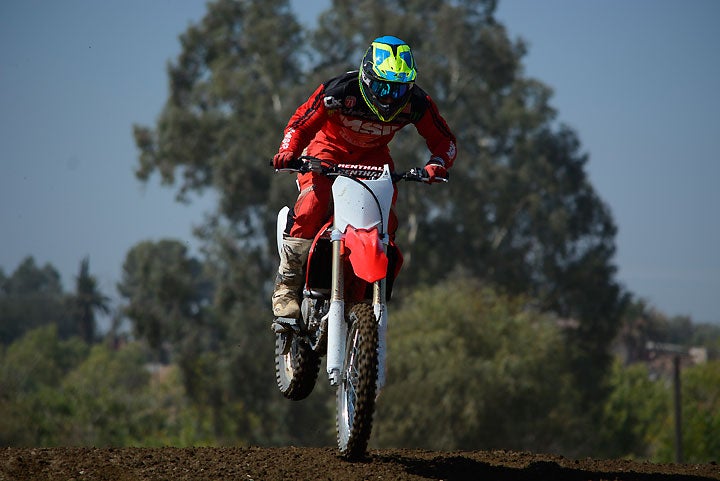
“Once you sort out its suspension, it handle really well,” Garvin noted. “The rear end stays right in line with the front, and you don’t have to fight the bike at all when you’re in a rut. It feels very planted, front and rear. It doesn’t move around a lot at speed, and it corners really well. The front end feel is excellent, and you can put it wherever you want and be really aggressive without worrying about it pushing wide off a corner. You can put it wherever you want to on the track.”
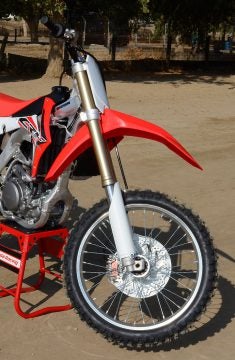
And while we’ve found that many air fork-equipped motocross and off-road bikes are really sensitive when it comes to finding the right adjustments, we still have to credit the CRF250R’s 49mm Showa (SFF TAC) air fork, which features three adjustable air chambers in the left leg and a damping cartridge in the right leg to deliver 12.2 inches of suspension travel. On the damping side, the rider can choose from among 16 clicker settings to tune the compression and 16 to tune the rebound damping. The 2017 version retains the 5mm longer fork legs that were incorporated into the 2016 CRF250R.
Out back, the CRF250R’s fully adjustable Showa piggyback reservoir single-shock, which received minor valving changes and twice as many clicker positions as last year. The shock offers 34 positions for rebound damping, 26 positions for low-speed compression damping 3.5 turns of high-speed compression damping. The linkage ratio of the 250’s Pro-Link rear suspension system is unchanged. Rear suspension travel is 12.3 inches.
After just few laps of his first test session, Garvin returned and Honda’s Jason Abbott make changes to the CRF’s suspension. Just as we experienced last year with DirtBikes.com tester Ryan Abbatoye, the Honda’s stock fork settings are on the harsh side, which made the front end jittery in higher speed sections on the track. Here is the complete listing of Honda’s recommended stock suspension settings for the CRF250R:
-Fork height: First line above triple clamp
-Fork inner chamber: 156 psi
-Fork outer chamber: 9 psi
-Fork balance chamber: 156 psi
-Fork compression damping: 7 clicks out from full damping
-Fork rebound damping: 29 clicks out from full damping
-HPSD (steering damper): 9 positions out from full damping
-Rear sag height: 105mm
-Shock low-speed compression damping: 10 clicks out from full damping
-Shock high-speed compression damping: 3 turns out from full damping
-Shock rebound damping: 7 clicks out from full damping.
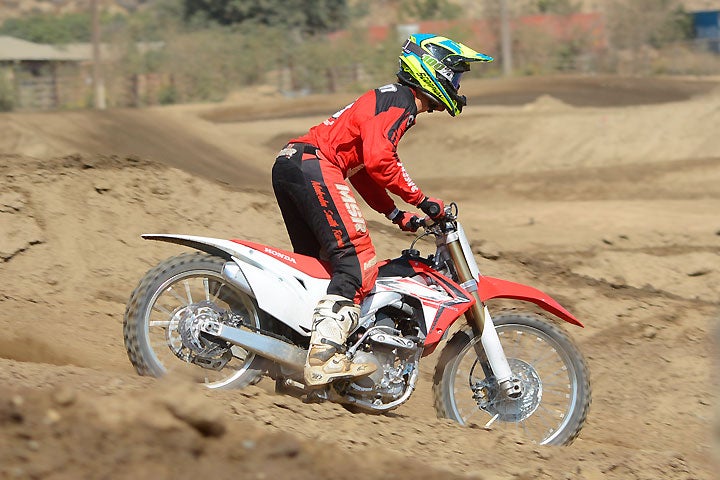
Bringing the fork into line with the stock shock settings required only minimal changes. Honda’s Jason Abbott dialed back the SFF-TAC’s outer chamber pressure from 9 psi to 6 psi and then cranked in three more clicks of rebound damping. Problem solved.
“Once we brought everything into balance, the suspension worked a lot better,” Garvin said. “Showa makes a pretty nice air fork for the CRF250R. It’s smooth in braking bumps, and it can handle big hits without bottoming. The stock suspension works really well.”
The Honda also boasts a comfortable cockpit with one notable exception. Its seat is flat and narrow, and its handlebar is well placed but Garvin commented that he caught his boots on the CRF’s freakishly pointed radiator shrouds. It’s something we’ve moaned about for the past couple years, and it appears to be taken care of on Honda’s new 2017 CRF450R. Fans of the CRF250R will have to wait for another year.
On the plus side CRF250R customers will also have to wait for a price increase, as the 2017 model’s MSRP has been held firm at $7599 for the third consecutive year. Granted, the evolution of some of the other bikes in its class leave the CRF250R not as high a value proposition as it was a year ago, but we certainly wouldn’t recommend turning away from one if you can find a good deal on it. Throw on an aftermarket pipe and maybe add some headwork and a different cam, and the CRF250R has the potential to be a red hot machine. Its chassis and suspension are excellent already.
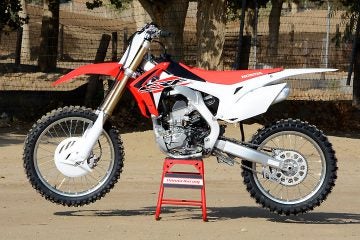 2017 Honda CRF250R Specifications
2017 Honda CRF250R Specifications
MSRP: $7599
Engine Type: 249cc liquid-cooled single-cylinder four-stroke
Bore and Stroke: 76.8mm x 53.8mm
Compression Ratio: 13.8:1
Valve Train: Unicam®, four-valve; 30.5mm intake, titanium; 25mm exhaust, titanium
Induction: Dual-Timing PGM-FI, 46mm throttle body
Ignition: Full transistor with electronic advance
Transmission: Close-ratio five-speed
Final Drive: #520 chain; 13T/49T
Suspension
Front: 49mm inverted Showa SFF-Air fork with 30-position rebound and 30-position compression damping adjustability; 12.2 inches travel
Rear: Pro-Link Showa single shock with adjustable spring preload, 34-position rebound damping adjustability, and compression damping adjustment separated into low-speed (26 positions) and high-speed (3.5 turns); 12.3 inches travel
Brakes
Front: Single 260mm wave-style disc with twin-piston caliper
Rear: Single 240mm wave-style disc
Tires
Front: Dunlop GEOMAX MX52 80/100-21
Rear: Dunlop GEOMAX MX52 100/90-19
Wheelbase: 58.6 inches
Rake: 27° 23’
Trail: 118mm (4.6 inches)
Seat Height: 37.4 inches
Ground Clearance: 12.7 inches
Fuel Capacity: 1.7 gallons
Color: Red
Claimed Curb Weight*: 231.0 pounds
*Includes all standard equipment, required fluids and full tank of fuel—ready to ride.
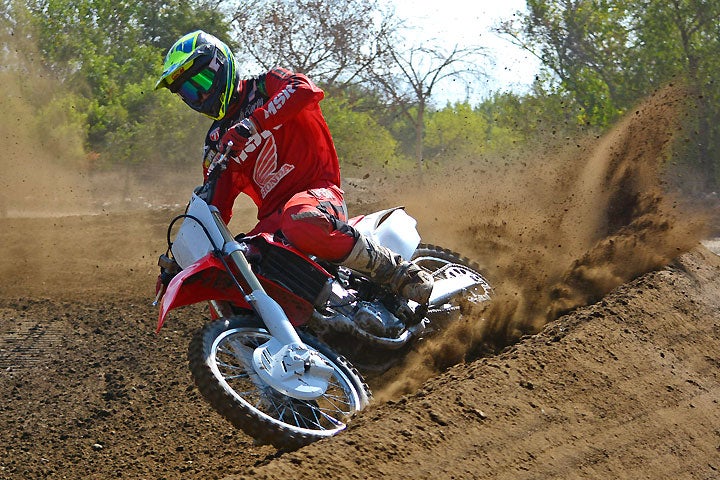
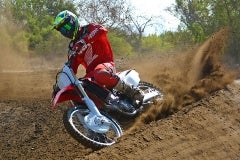
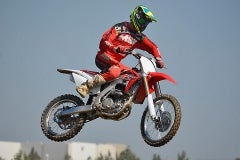
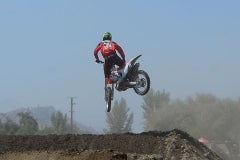
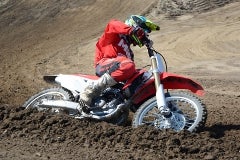
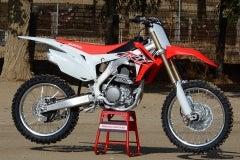
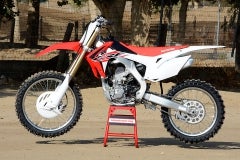
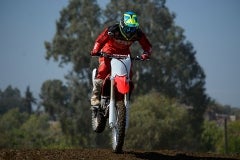
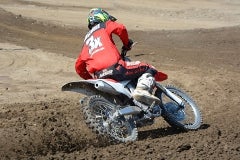
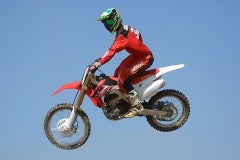
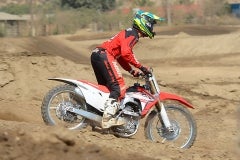
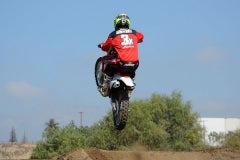
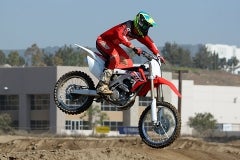
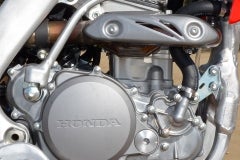
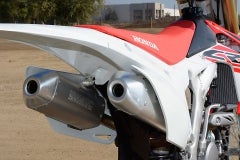
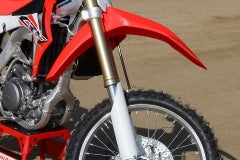
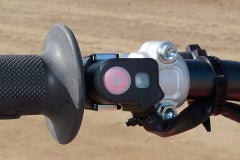
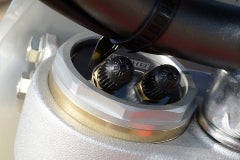
 Your Privacy Choices
Your Privacy Choices